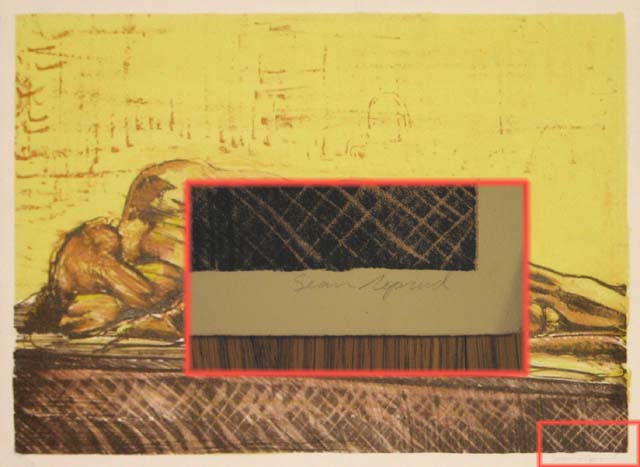Editioning is the process of preparing a set of prints. The prints must be signed, numbered, and gone through to make sure they are all the same.
Traditionally, when a print is made, the printing elements are prepared (the blocks, metal plates, or whatever else the artist creates to print off of), then numerous copies of the print are made.
The set of identical prints is called an edition. Most fine art prints are made in editions, and when I was in college, this is how I made my prints.
There are a few conventions to prints in an edition, I’d like to explain to you.
I’m going to use this lithograph of mine to explain. This is the first thing I could find in my easily accessible portfolio. Most of my stuff is stored under my bed!

I did this drawing on a lithographic stone during a figure drawing session. I liked it enough to work up a couple of color plates and make an edition out of it.
Edition Number
In any edition, each print has a number. The number is given as a fraction, indicating which number print you are looking at, and how many prints were made total.

In this case, the “1/18” indicates that is print number 1 from the edition, and 18 total prints were made in this edition.
If all you see is the fraction, then each one of the prints in the series should be exactly the same. The goal of an edition, after all, is to make an identical set of prints.
You may sometimes see the letters “E.V.” after the number. This means “Edition Varie” (edition very-AY). This means that not every print is exactly the same. The artist has created variety in the set on purpose. The most common variety found is the colors. The artist may print form the same block, but use different colors each time, so that even though the image is the same, the colors are different from print to print.
The other thing you may see on a print is the letters “A.P.” instead of a number. This means “Artist’s Proof”. It is a completed print, but is not part of the edition. Artist’s Proofs do not get numbers.
When a fine art print is released by a print studio, the number in the edition, and the number of artists prints is included in the solicitation. They may release an announcement like, “An edition of 25 prints with 5 Artist’s Proofs”.
Artist’s Signature and Title
The edition number is the most complicated part of the print to explain. The rest is easy. The next thing to notice is the signature. The signature is usually in the bottom right corner of the print, as you see below.

A print, after all, should be signed!
Last of all is the title. I don’t have a picture to show you of the title of this lithograph, because, well, I never titled it.
Yes! It’s embarrassing! I never titles this print. If I had, however, the title would have been written smack dab in the middle of the print, right underneath the image. The title of this print probably would have been something boring like Figure Drawing III.
A Light Touch
The last thing that you will notice is that signed and numbered this print in pencil instead of pen. This is common, and you will most likely find prints signed and numbered in pencil. The reason for this is that pencil has a softer color, and a lighter touch than a pen. Or so I imagine.
It could very well be that when editioning of prints had started, pens weren’t invented yet (probably not though).
Either way, the information about the print is written in pencil so that it is lighter in color and does not draw attention away from the print. THe title, number, and signature should be able to be seen if you want to , but should not distract you when you look at the print from a few feet away.
= = = = = = =
There you go, a quick crash course in editioning prints!
Next up, I’ll let you know why I am throwing this convention out the window for my 101 Woodblock Series.
Tags: Edition, Lithography, Printmaking
This was really interesting, and I learned several things about how prints are marketed.
Very curious to see what you have up your sleeve next.
.-= Dave Doolin´s last blog post ..Testimonials, Disclaimers, Disclosure and the Federal Trade Commission =-.